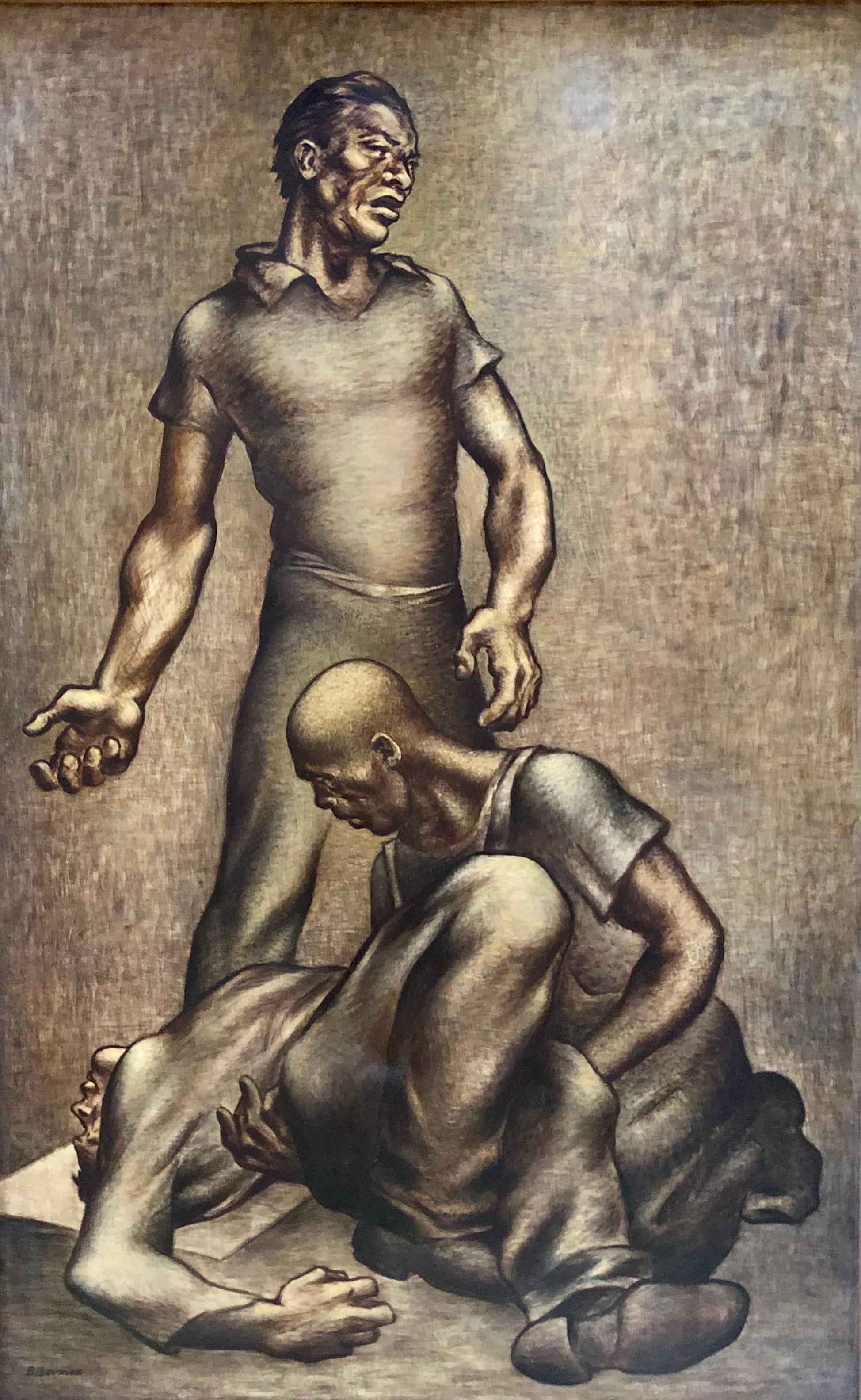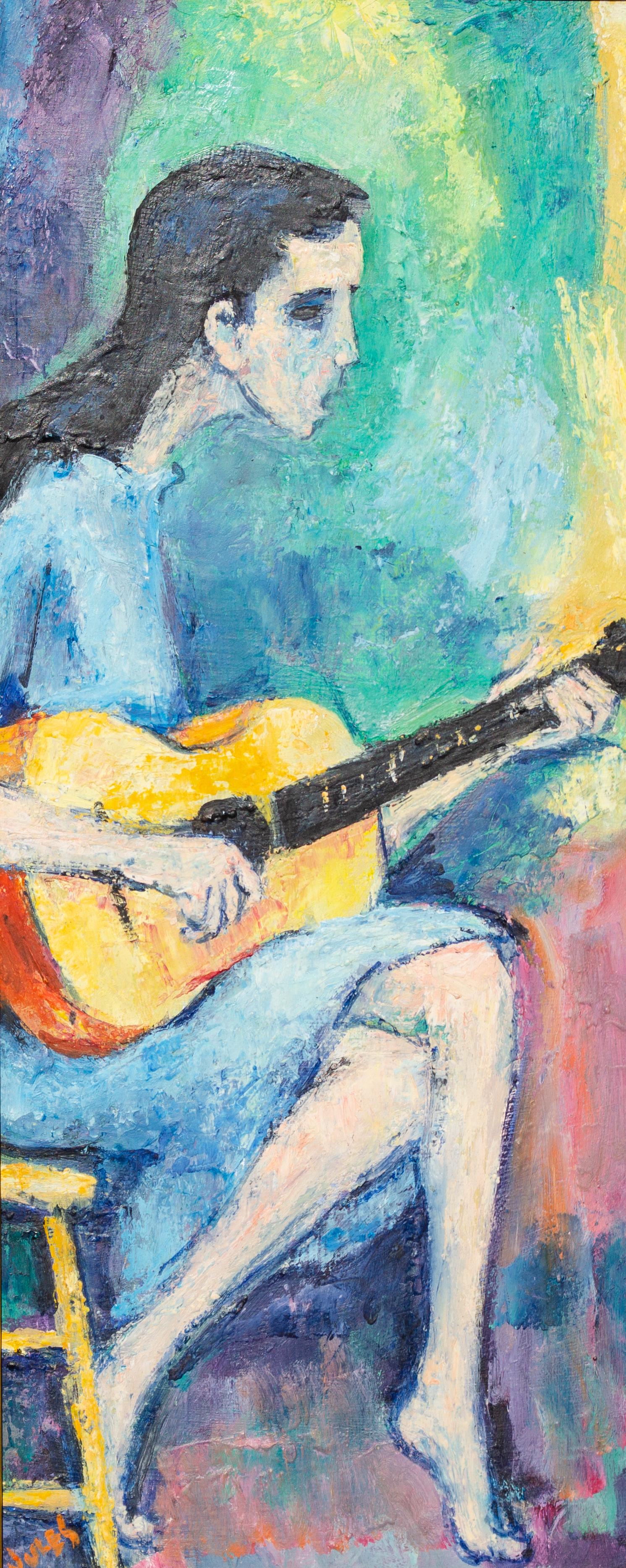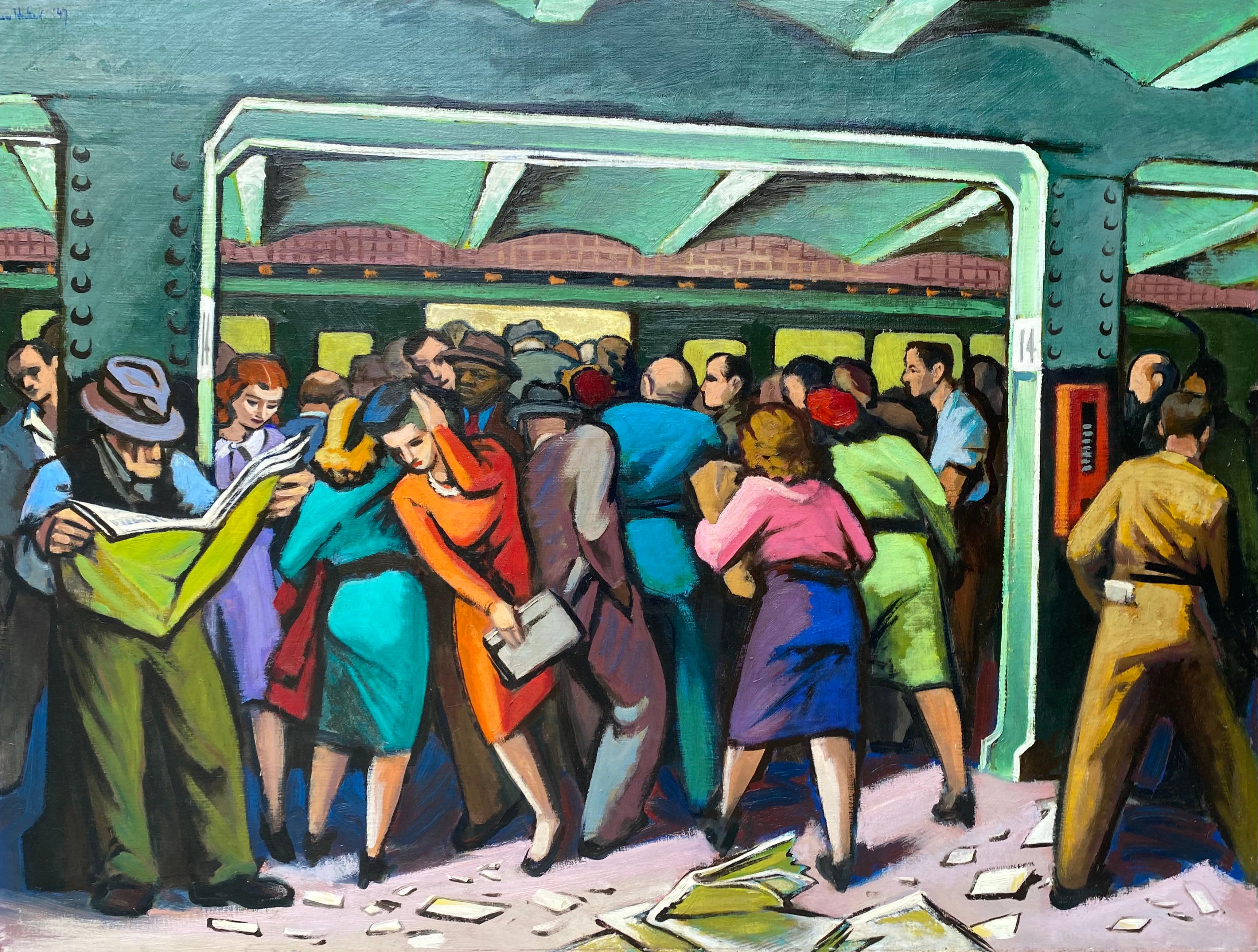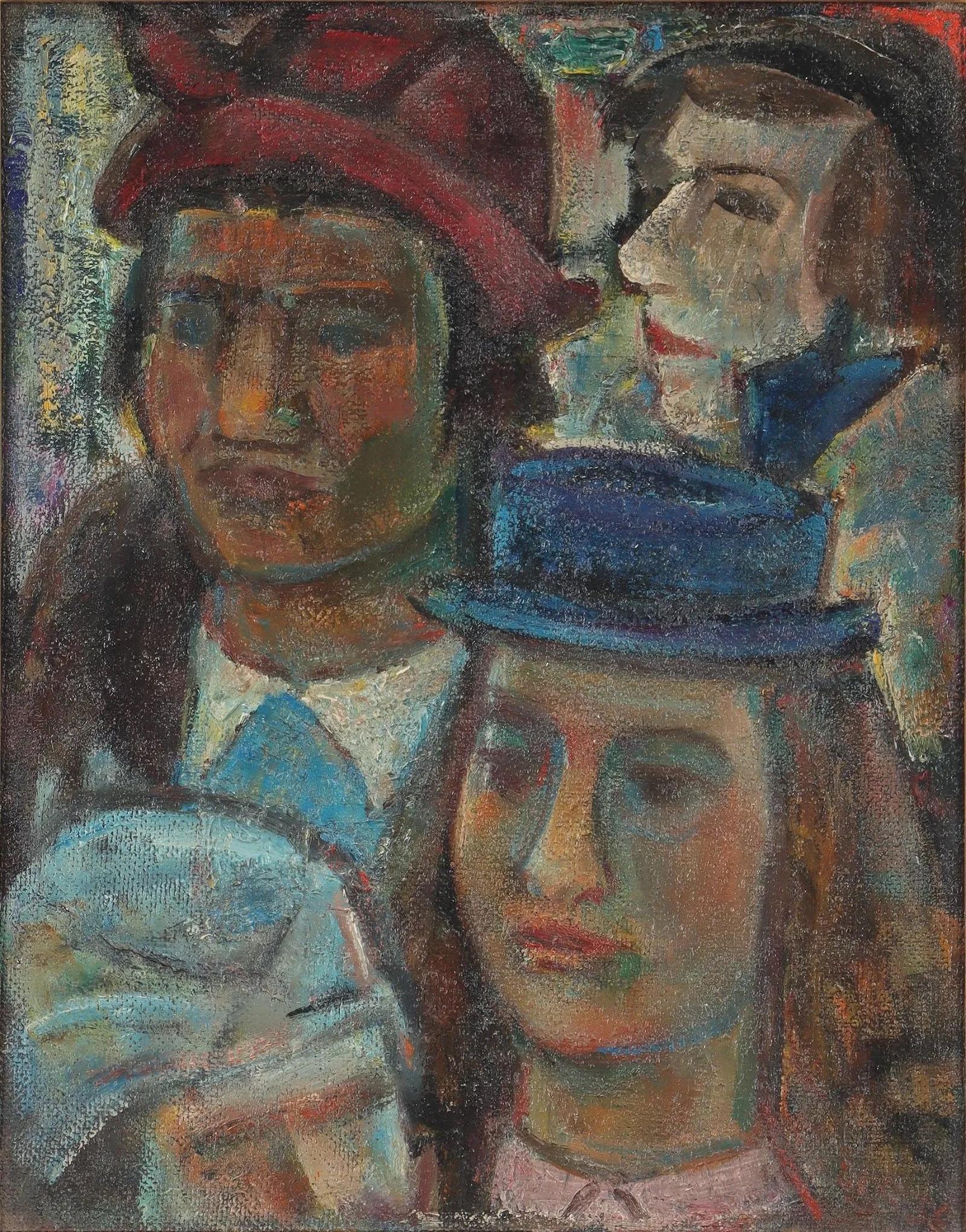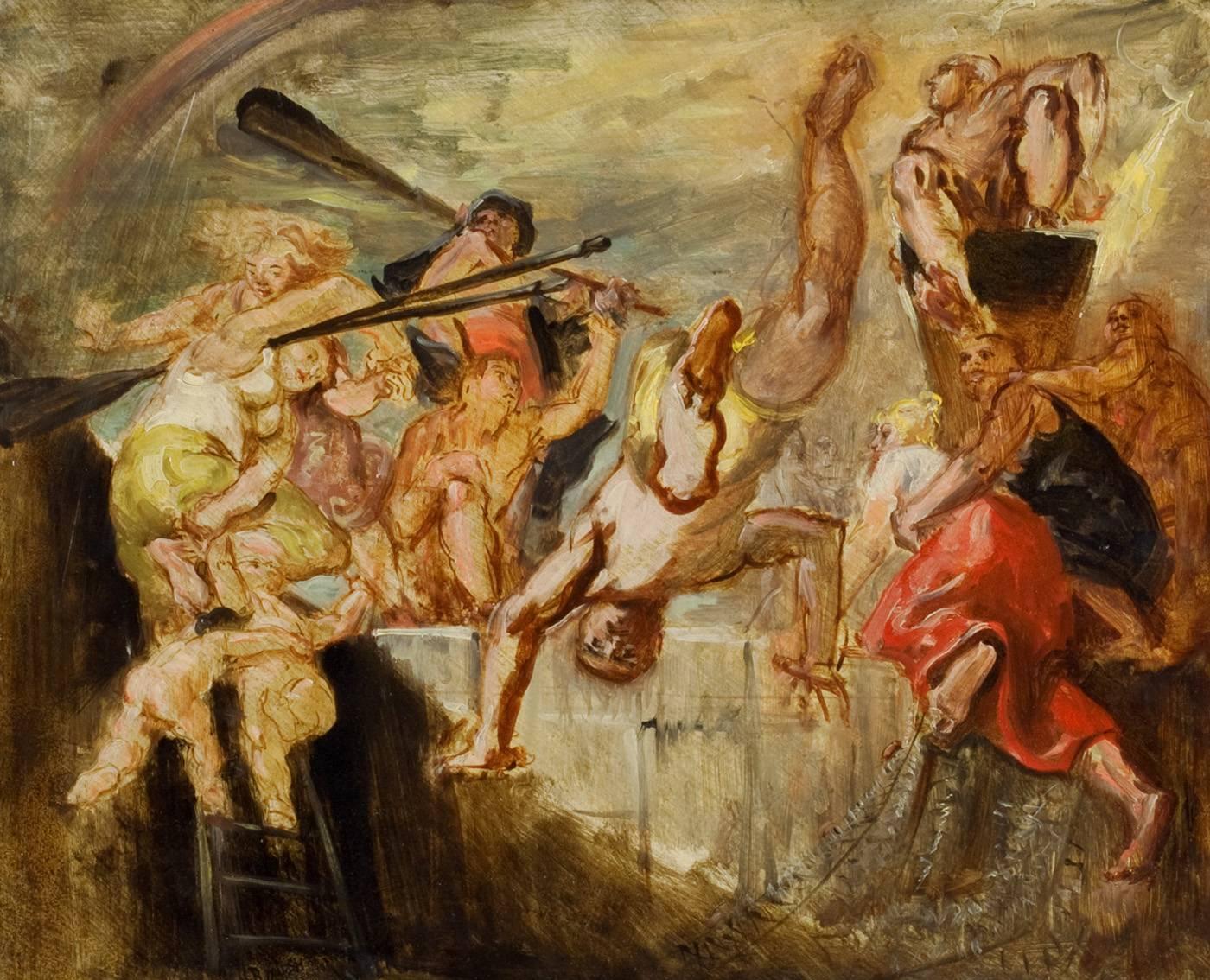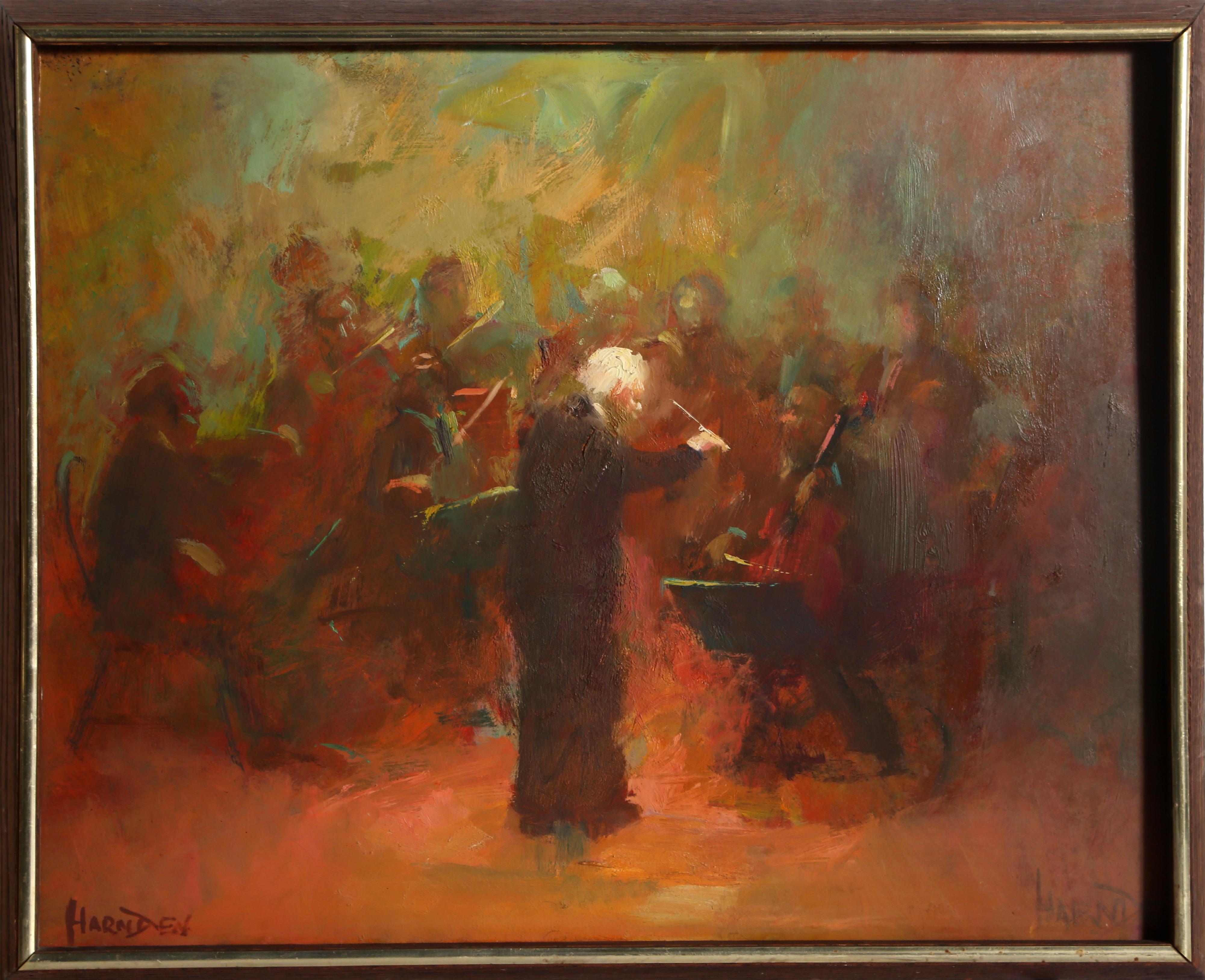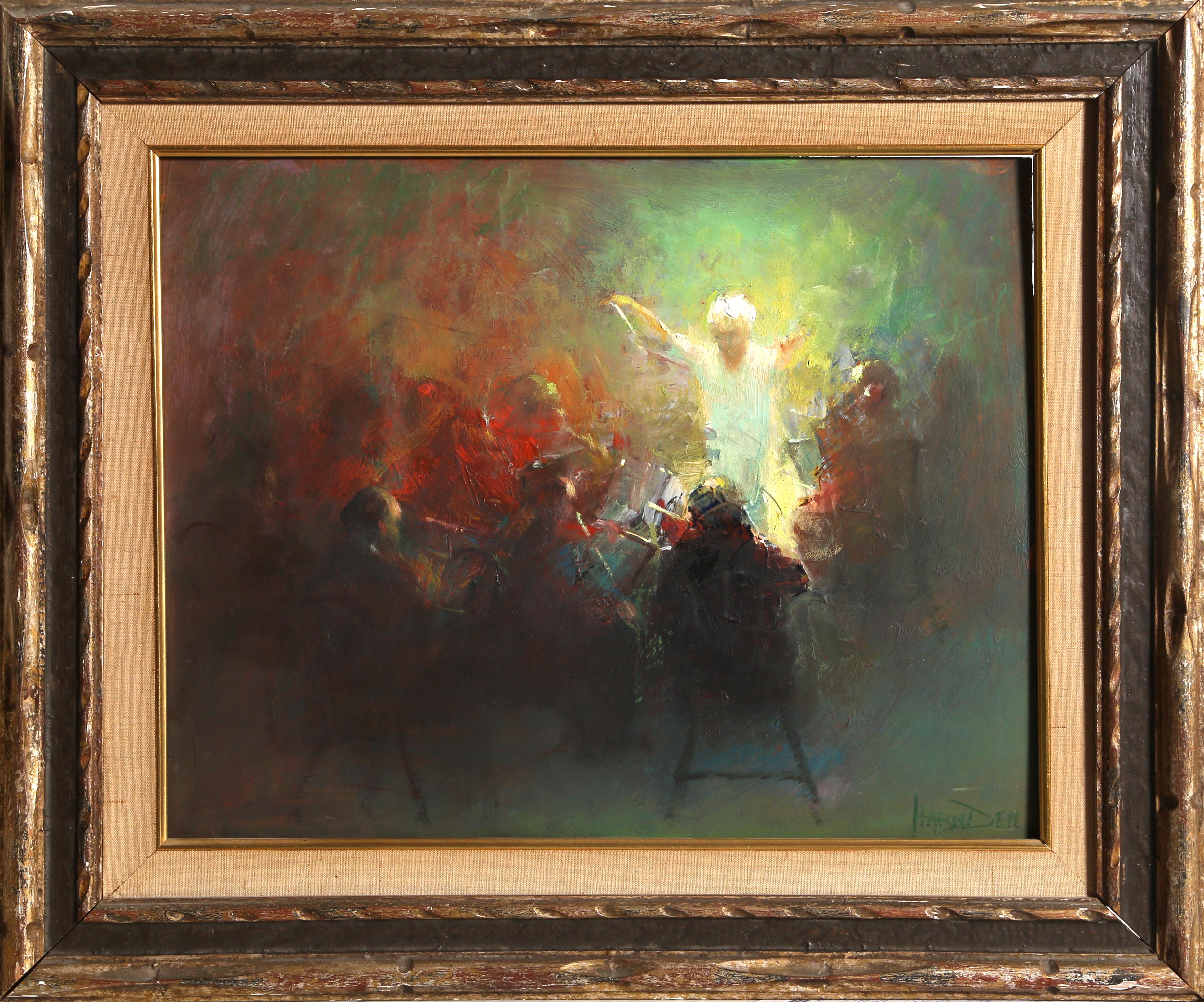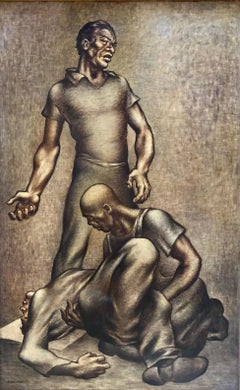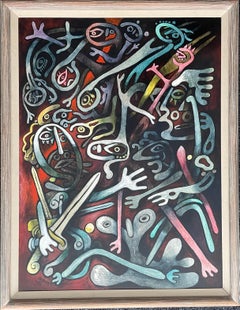
Woman at High Tea Modernist African American Large Oil Painting
View Similar Items
Want more images or videos?
Request additional images or videos from the seller
1 of 9
Alvin C. HollingsworthWoman at High Tea Modernist African American Large Oil Painting
About the Item
- Creator:Alvin C. Hollingsworth (1928 - 2000)
- Dimensions:Height: 39.5 in (100.33 cm)Width: 29 in (73.66 cm)
- Medium:
- Movement & Style:
- Period:
- Condition:unframed.
- Gallery Location:Surfside, FL
- Reference Number:Seller: 9941stDibs: LU3822334271
About the Seller
4.9
Platinum Seller
These expertly vetted sellers are 1stDibs' most experienced sellers and are rated highest by our customers.
Established in 1995
1stDibs seller since 2014
1,550 sales on 1stDibs
Typical response time: 1 hour
More From This SellerView All
- 1927 Oil Painting Eiffel Tower Paris American Modernist Wpa Artist Morris KantorBy Morris KantorLocated in Surfside, FLMorris Kantor New York (1896 - 1974) Paris from the Ile St. Louis, 1927 (view of Eiffel Tower) Oil painting on canvas Hand Signed lower left. Provenance: Hirshhorn Museum and Sculpture Garden, Smithsonian Institution ( bears label verso) Size: 20 3/4"H x 28 1/8"W (sight), 28.75 "H x 36"W (framed) Morris Kantor (Belarusian: Морыс Кантор) (1896-1974) was a Russian Empire-born American painter based in the New York City area. Born in Minsk on April 15, 1896, Kantor was brought to the United States in 1906 at age 10, in order to join his father who had previously relocated to the states. He made his home in West Nyack, New York for much of his life, and died there in 1974. He produced a prolific and diverse body of work, much of it in the form of paintings, which is distinguished by its stylistic variety over his long career. Perhaps his most widely recognized work is the iconic painting "Baseball At Night", which depicts an early night baseball game played under artificial electric light. Although he is best known for his paintings executed in a realistic manner, over the course of his life he also spent time working in styles such as Cubism and Futurism, and produced a number of abstract or non-figural works. A famous cubist, Futurist, painting of his "Orchestra" brought over 500,000$ at Christie's auction house in 2018 Kantor found employment in the Garment District upon his arrival in New York City, and was not able to begin formal art studies until 1916, when he began courses at the now-defunct Independent School of Art. He studied landscape painting with Homer Boss (1882-1956). In 1928, after returning to New York City from a year in Paris, Kantor developed a style in which he combined Realism with Fantasy, often taking the streets of New York as his subject matter. He did some moody Surrealist Nude paintings and fantasy scenes. In the 1940's he turned towards figural studies. Later in his career, Kantor himself was an instructor at the Cooper Union and also at the Art Students League of New York in the 1940s, and taught many pupils who later became famous artists in their own right, such as Knox Martin, Robert Rauschenberg, Sigmund Abeles and Susan Weil...Category
1920s American Modern Landscape Paintings
MaterialsCanvas, Oil
- Large Modernist Oil Painting 1940s, Judaica Hasidic Shtetl Wagon Driver WPA EraBy Emanuel Glicenstein RomanoLocated in Surfside, FLGenre: Modern Subject: Landscape with figure of horse, driver and wagon Medium: Oil Surface: wood Board EMANUEL ROMANO Rome, Italy, b. 1897, d. 1984 Emanuel Glicen Romano was born in Rome, September 23, 1897. His father Henryk Glicenstein was a sculptor and was living in Rome with his wife Helena (born Hirszenberg) when Emanuel was born. His father obtained Italian citizenship and adopted the name Enrico. Emanuel was brought up in Italy, Switzerland, Germany, England and Poland. In 1926 Emanuel Glicenstein Romano and his father sailed for New York. They briefly visited Chicago. Romano's sister, Beatrice, and mother only joined them in New York years later. Romano changed his name on his arrival to America and some have erroneously speculated that this was to avoid antisemitic discrimination. In truth, as the son of a highly-regarded artist, Romano changed his name to ensure that any success or recognition he would later attain, would be the result of nothing other than his own merit as an artist, and not on account of his father's fame. In 1936 Romano was worked for the WPA Federal Art Project creating murals. ( there were many jewish artists active with in the WPA period. notably Chaim Gross, Ben Shahn, Isaac and Moses Soyer, Abraham Rattner and many others. During and immediately after World War II, Romano created a series of allegorical works depicting graphic holocaust images that were held closely by the family until after his passing. One of these works is now on permanent display in the Florida Holocaust Museum in St. Petersburg Florida. Emanuel's father died in 1942 in a car accident before they could realize their shared dream of visiting Israel. In 1944 Romano, having completed his degree at the Pennsylvania Academy of Fine Arts and the Art Institute of Chicago, began teaching at the City College of New York. Romano moved to Safed, Israel in 1953 and established an art museum in his father's memory, the Glicenstein Museum. COLLECTIONS Indianapolis Museum of Art Metropolitan Museum of Art Boston Fine Arts Museum Fogg Museum Musée Nacional de France Recently his work has been added to the Florida Holocaust Museum collection. His notable works include his holocaust themed allegorical paintings as well as portraits of Marianne Moore, his father and William Carlos Williams...Category
1930s American Modern Figurative Paintings
MaterialsOil, Board
- Holocaust Memorial Oil Painting Judaica Rabbi Composed of Figures Artists FrameBy Maurice NewmanLocated in Surfside, FLMaurice Newman was active/lived in Massachusetts / Lithuania. Maurice Newman is known for sculpture-abstraction, impressionist landscape painting, diorama. Born in Lithuania, Mauric...Category
1960s American Modern Portrait Paintings
MaterialsOil
- Abstract Procession Jewish Wedding Chuppah Oil Painting Modernist JudaicaBy Sabina TeichmanLocated in Surfside, FLGenre: Modern Subject: Abstract Medium: Oil Surface: Canvas Country: United States Sabina Teichman: (1905-1983) Studied at Columbia Univ. (BA, MA), also with Charles J. Martin and A...Category
1950s American Modern Figurative Paintings
MaterialsCanvas, Oil
- Oil Painting by Well Known Cartoonist and Illustrator Upper East Side, ManhattanBy Sandy HuffakerLocated in Surfside, FLAn Upper East Side of Manhattan New York city scene of bald guy reading newspaper on bench with East River and tugboat in background. The 1970s were the “glory days,” Huffaker says, for himself and a stable of talented illustrators whose work routinely found itself on the covers of the nation’s premier newsmagazines and in the pages of The New York Times. For the better part of that decade, Huffaker was among an elite breed of commercial artists—his hero and fellow Southerner Jack Davis, the legendary Mad Magazine illustrator, among them—working during a remarkable period when art directors routinely turned to illustration to give comic relief to the country’s deeply serious and dark problems. From civil rights and the women’s movement to Vietnam and Watergate, the gas crisis and inflation to the rise of Jimmy Carter, Huffaker mined a deep well of material ripe for his brand of visual wit and caustic satire. He sent his portfolio to children's book illustrator Maurice Sendak, the legendary “Where The Wild Things Are” illustrator to gauge his prospects, and when Sendak replied, “C’mon up, you’ll do all right,” SELECT HONORS: 2 Page-One Awards (from the New York Newspaper Guild), for work in Fortune Magazine and Sports Illustrated. Nominated 3 times for Cartoonist-of-the-Year by the National Cartoonists Society (illustration category). Desi Award of Excellence (Graphic Design Magazine). 20 Award of Merit citations from the Society of Illustrators. One-man show, Society of Illustrators. Illustrators 22 - annual national exhibition for the Society of Illustrators. SELECT MAGAZINE COVERS Time Magazine (6), Sports Illustrated (2), Business Week (12), Forbes, Saturday Review, New York Times Sunday Magazine, The New Republic, Family Weekly, Madison Avenue, New York Daily News Sunday Magazine (2), Junior Scholastic, ACLU, The Nation , and more EDUCATION BA, University of Alabama. Attended Pratt Graphic Center and The Art Students League, New York City. BOOKS WRITTEN AND ILLUSTRATED The Dispensible Man (M. Evans and Co.) and The Bald Book (M. Evans and Co.) BOOKS ILLUSTRATED White Is (Grove Press), The Begatting of a President (Ballantine Books), The Biggest Sneeze (Harper-Collins), H. Phillip Birdsong's ESP (Young Scott Books), Kids Letters to President Reagan (M. Evans), The Worlds Greatest Left-Handers (M. Evans), Does My Room Come Alive at Night (HarperCollins), The Man With Big Ears (HarperCollins), Jake Snake's Race (HarperCollins), and more POLITICAL CARTOONING Political cartoonist at The News and Obsever in Raleigh, NC and syndicated during the early 70's. Today, syndicated in 750 publications 3-times a week with Cagle Cartoons. FINE ART SHOWS Allied Artists of America, Salmagundi Club, Phillips Mill Annual (honorable mention), New Hope Shad Festival (grand Prize), Hunter Museum in Chattanooga ( one -man career retrospective), Santa Fe public library (one--man), Rosenfeld Gallery (Philadelphia), Potter...Category
20th Century American Modern Figurative Paintings
MaterialsCanvas, Oil
- Modernist Oil Painting 1940s, Judaica Hasidic Rabbi in JerusalemBy Emanuel Glicenstein RomanoLocated in Surfside, FLGenre: Portrait Subject: Landscape Medium: Oil Surface: Board Country: United States EMANUEL ROMANO Rome, Italy, b. 1897, d. 1984 Emanuel Glicenstein Romano was born in Rome, September 23, 1897. His father Henryk Glicenstein was a sculptor and was living in Rome with his wife Helena (born Hirszenberg) when Emanuel was born. His father obtained Italian citizenship and adopted the name Enrico. Emanuel was brought up in Italy, Switzerland, Germany, England and Poland. In 1926 Emanuel and his father sailed for New York. They briefly visited Chicago. Romano's sister, Beatrice, and mother only joined them in New York years later. Romano changed his name on his arrival to America and some have erroneously speculated that this was to avoid antisemitic discrimination. In truth, as the son of a highly-regarded artist, Romano changed his name to ensure that any success or recognition he would later attain, would be the result of nothing other than his own merit as an artist, and not on account of his father's fame. In 1936 Romano was worked for the Federal Art Project creating murals. During and immediately after World War II, Romano created a series of allegorical works depicting graphic holocaust images that were held closely by the family until after his passing. One of these works is now on permanent display in the Florida Holocaust Museum in St. Petersburg Florida. Emanuel's father died in 1942 in a car accident before they could realize their shared dream of visiting Israel. In 1944 Romano, having completed his degree at the Pennsylvania Academy of Fine Arts and the Art Institute of Chicago, began teaching at the City College of New York. Romano moved to Safed, Israel in 1953 and established an art museum in his father's memory, the Glicentein Museum. COLLECTIONS Indianapolis Museum of Art Metropolitan Museum of Art Boston Fine Arts Museum Fogg Museum Musée Nacional de France Recently his work has been added to the Florida Holocaust Museum collection. His notable works include his holocaust themed allegorical paintings as well as portraits of Marianne Moore, his father and William Carlos Williams...Category
1970s American Modern Figurative Paintings
MaterialsOil, Board
You May Also Like
- Fallen Comrades/InterludeLocated in Los Angeles, CAThis work is part of our exhibition - America Coast to Coast: Artists of the 1940s Fallen Comrades/Interlude, 1949, oil on masonite, signed lower left, 35 x 56 inches; Gallery Z la...Category
1940s American Modern Paintings
MaterialsMasonite, Oil
Price Upon Request - The Magician oil and tempera painting by Julio de DiegoBy Julio de DiegoLocated in Hudson, NYJulio De Diego’s Atomic Series paintings made an extraordinary statement regarding the shock and fear that accompanied the dawn of the nuclear age. In the artist’s own words, “Scientists were working secretly to develop formidable powers taken from the mysterious depths of the earth - with the power to make the earth useless! Then, the EXPLOSION! . . . we entered the Atomic Age, and from there the neo-Atomic war begins. Explosions fell everywhere and man kept on fighting, discovering he could fight without flesh.” To execute these works, De Diego developed a technique of using tempera underpainting before applying layer upon layer of pigmented oil glazes. The result is paintings with surfaces which were described as “bonelike” in quality. The forms seem to float freely, creating a three-dimensional visual effect. In the 1954 book The Modern Renaissance in American Art, author Ralph Pearson summarizes the series as “a fantastic interpretation of a weighty theme. Perhaps it is well to let fantasy and irony appear to lighten the devastating impact. By inverse action, they may in fact increase its weight.” Exhibited 1964 Marion Koogler McNay Art Institute, San Antonio, Texas This work retains its original frame which measures 54" x 42" x 2" About this artist: Julio De Diego crafted a formidable persona within the artistic developments and political struggles of his time. The artist characterized his own work as “lyrical,” explaining, “through the years, the surrealists, the social-conscious painters and the others tried to adopt me, but I went my own way, good, bad or indifferent.” [1] His independence manifested early in life when de Diego left his parent’s home in Madrid, Spain, in adolescence following his father’s attempts to curtail his artistic aspirations. At the age of fifteen he held his first exhibition, set up within a gambling casino. He managed to acquire an apprenticeship in a studio producing scenery for Madrid’s operas, but moved from behind the curtains to the stage, trying his hand at acting and performing as an extra in the Ballet Russes’ Petrouchka with Nijinsky. He spent several years in the Spanish army, including a six-month stretch in the Rif War of 1920 in Northern Africa. His artistic career pushed ahead as he set off for Paris and became familiar with modernism’s forays into abstraction, surrealism, and cubism. The artist arrived in the U.S. in 1924 and settled in Chicago two years later. He established himself with a commission for the decoration of two chapels in St. Gregory’s Church. He also worked in fashion illustration, designed magazine covers and developed a popular laundry bag for the Hotel Sherman. De Diego began exhibiting through the Art Institute of Chicago in 1929, and participated in the annual Chicago Artists Exhibitions, Annual American Exhibitions, and International Water Color Exhibitions. He held a solo exhibition at the Art Institute of Chicago in the summer of 1935. Though the artist’s career was advancing, his family life had deteriorated. In 1932 his first marriage dissolved, and the couple’s young daughter Kiriki was sent to live with friend Paul Hoffman. De Diego continued to develop his artistic vocabulary with a growing interest in Mexican art. He traveled throughout the country acquainting himself with the works of muralists such as Carlos Merida, and also began a collection of small native artifacts...Category
1940s American Modern Abstract Paintings
MaterialsMasonite, Oil, Tempera
- St. Atomic oil and tempera painting by Julio de DiegoBy Julio de DiegoLocated in Hudson, NYJulio De Diego’s Atomic Series paintings made an extraordinary statement regarding the shock and fear that accompanied the dawn of the nuclear age. In the artist’s own words, “Scientists were working secretly to develop formidable powers taken from the mysterious depths of the earth - with the power to make the earth useless! Then, the EXPLOSION! . . . we entered the Atomic Age, and from there the neo-Atomic war begins. Explosions fell everywhere and man kept on fighting, discovering he could fight without flesh.” To execute these works, De Diego developed a technique of using tempera underpainting before applying layer upon layer of pigmented oil glazes. The result is paintings with surfaces which were described as “bonelike” in quality. The forms seem to float freely, creating a three-dimensional visual effect. In the 1954 book The Modern Renaissance in American Art, author Ralph Pearson summarizes the series as “a fantastic interpretation of a weighty theme. Perhaps it is well to let fantasy and irony appear to lighten the devastating impact. By inverse action, they may in fact increase its weight.” Exhibited 1950 University of Illinois at Urbana "Contemporary American Painting" 1964 Marion Koogler McNay Art Institute, San Antonio, Texas This work retains its original frame which measures 54" x 36" x 2". About this artist: Julio De Diego crafted a formidable persona within the artistic developments and political struggles of his time. The artist characterized his own work as “lyrical,” explaining, “through the years, the surrealists, the social-conscious painters and the others tried to adopt me, but I went my own way, good, bad or indifferent.” [1] His independence manifested early in life when de Diego left his parent’s home in Madrid, Spain, in adolescence following his father’s attempts to curtail his artistic aspirations. At the age of fifteen he held his first exhibition, set up within a gambling casino. He managed to acquire an apprenticeship in a studio producing scenery for Madrid’s operas, but moved from behind the curtains to the stage, trying his hand at acting and performing as an extra in the Ballet Russes’ Petrouchka with Nijinsky. He spent several years in the Spanish army, including a six-month stretch in the Rif War of 1920 in Northern Africa. His artistic career pushed ahead as he set off for Paris and became familiar with modernism’s forays into abstraction, surrealism, and cubism. The artist arrived in the U.S. in 1924 and settled in Chicago two years later. He established himself with a commission for the decoration of two chapels in St. Gregory’s Church. He also worked in fashion illustration, designed magazine covers and developed a popular laundry bag for the Hotel Sherman. De Diego began exhibiting through the Art Institute of Chicago in 1929, and participated in the annual Chicago Artists Exhibitions, Annual American Exhibitions, and International Water Color Exhibitions. He held a solo exhibition at the Art Institute of Chicago in the summer of 1935. Though the artist’s career was advancing, his family life had deteriorated. In 1932 his first marriage dissolved, and the couple’s young daughter Kiriki was sent to live with friend Paul Hoffman. De Diego continued to develop his artistic vocabulary with a growing interest in Mexican art. He traveled throughout the country acquainting himself with the works of muralists such as Carlos Merida, and also began a collection of small native artifacts...Category
1940s American Modern Abstract Paintings
MaterialsMasonite, Oil, Tempera
- Inevitable Day – Birth of the Atom oil and tempera painting by Julio De DiegoBy Julio de DiegoLocated in Hudson, NYJulio De Diego’s Atomic Series paintings made an extraordinary statement regarding the shock and fear that accompanied the dawn of the nuclear age. In the artist’s own words, “Scientists were working secretly to develop formidable powers taken from the mysterious depths of the earth - with the power to make the earth useless! Then, the EXPLOSION! . . . we entered the Atomic Age, and from there the neo-Atomic war begins. Explosions fell everywhere and man kept on fighting, discovering he could fight without flesh.” To execute these works, De Diego developed a technique of using tempera underpainting before applying layer upon layer of pigmented oil glazes. The result is paintings with surfaces which were described as “bonelike” in quality. The forms seem to float freely, creating a three-dimensional visual effect. In the 1954 book The Modern Renaissance in American Art, author Ralph Pearson summarizes the series as “a fantastic interpretation of a weighty theme. Perhaps it is well to let fantasy and irony appear to lighten the devastating impact. By inverse action, they may in fact increase its weight.” Bibliography Art in America, April 1951, p.78 About this artists: Julio De Diego crafted a formidable persona within the artistic developments and political struggles of his time. The artist characterized his own work as “lyrical,” explaining, “through the years, the surrealists, the social-conscious painters and the others tried to adopt me, but I went my own way, good, bad or indifferent.” [1] His independence manifested early in life when de Diego left his parent’s home in Madrid, Spain, in adolescence following his father’s attempts to curtail his artistic aspirations. At the age of fifteen he held his first exhibition, set up within a gambling casino. He managed to acquire an apprenticeship in a studio producing scenery for Madrid’s operas, but moved from behind the curtains to the stage, trying his hand at acting and performing as an extra in the Ballet Russes’ Petrouchka with Nijinsky. He spent several years in the Spanish army, including a six-month stretch in the Rif War of 1920 in Northern Africa. His artistic career pushed ahead as he set off for Paris and became familiar with modernism’s forays into abstraction, surrealism, and cubism. The artist arrived in the U.S. in 1924 and settled in Chicago two years later. He established himself with a commission for the decoration of two chapels in St. Gregory’s Church. He also worked in fashion illustration, designed magazine covers and developed a popular laundry bag for the Hotel Sherman. De Diego began exhibiting through the Art Institute of Chicago in 1929, and participated in the annual Chicago Artists Exhibitions, Annual American Exhibitions, and International Water Color Exhibitions. He held a solo exhibition at the Art Institute of Chicago in the summer of 1935. Though the artist’s career was advancing, his family life had deteriorated. In 1932 his first marriage dissolved, and the couple’s young daughter Kiriki was sent to live with friend Paul Hoffman. De Diego continued to develop his artistic vocabulary with a growing interest in Mexican art. He traveled throughout the country acquainting himself with the works of muralists such as Carlos Merida, and also began a collection of small native artifacts...Category
1940s American Modern Abstract Paintings
MaterialsMasonite, Oil, Tempera
- Mervin Jules Folk Singer Portrait, SignedBy Mervin JulesLocated in Larchmont, NYMervin Jules (American, 1912-1994) Folk Singer, 20th century Oil on masonite 18 x 7 1/2 in. Signed lower left: Jules Provenance: Garelick's Gallery, Detroit Matte included, no fram...Category
20th Century American Modern Figurative Paintings
MaterialsMasonite, Oil
- Victor, Colorado, 1940s Modernist Mountain Landscape with Town, Mining TownBy Martyl Suzanne Schweig LangsdorfLocated in Denver, CO'Victor, Colorado', 1942 oil painting on masonite by Martyl Suzanne Schweig (1918-2013). This classic Colorado landscape was painted overlooking a ghost town with the Rocky Mountains visible across the background, completed in rich tones of green, gold, and brown. This painting was completed on a trip with fellow artist, Adolph Dehn...Category
1940s American Modern Landscape Paintings
MaterialsMasonite, Oil
Recently Viewed
View AllMore Ways To Browse
Vintage Spotlight Other
Aero Vintage
Don Lewis
1970s Harlem
Black Cat Illustration Vintage
Norman Lewis
Richard Smith Bronze
Indian American Masks
Indian Bronze Dancer
Norman C Black Painting
Vintage Studio Spotlight
Charles Alston
Vintage Holly Drawing
Bronze Beetle
Police 1940s
Romare Bearden 1980
A C Hollingsworth
Indian Christ
